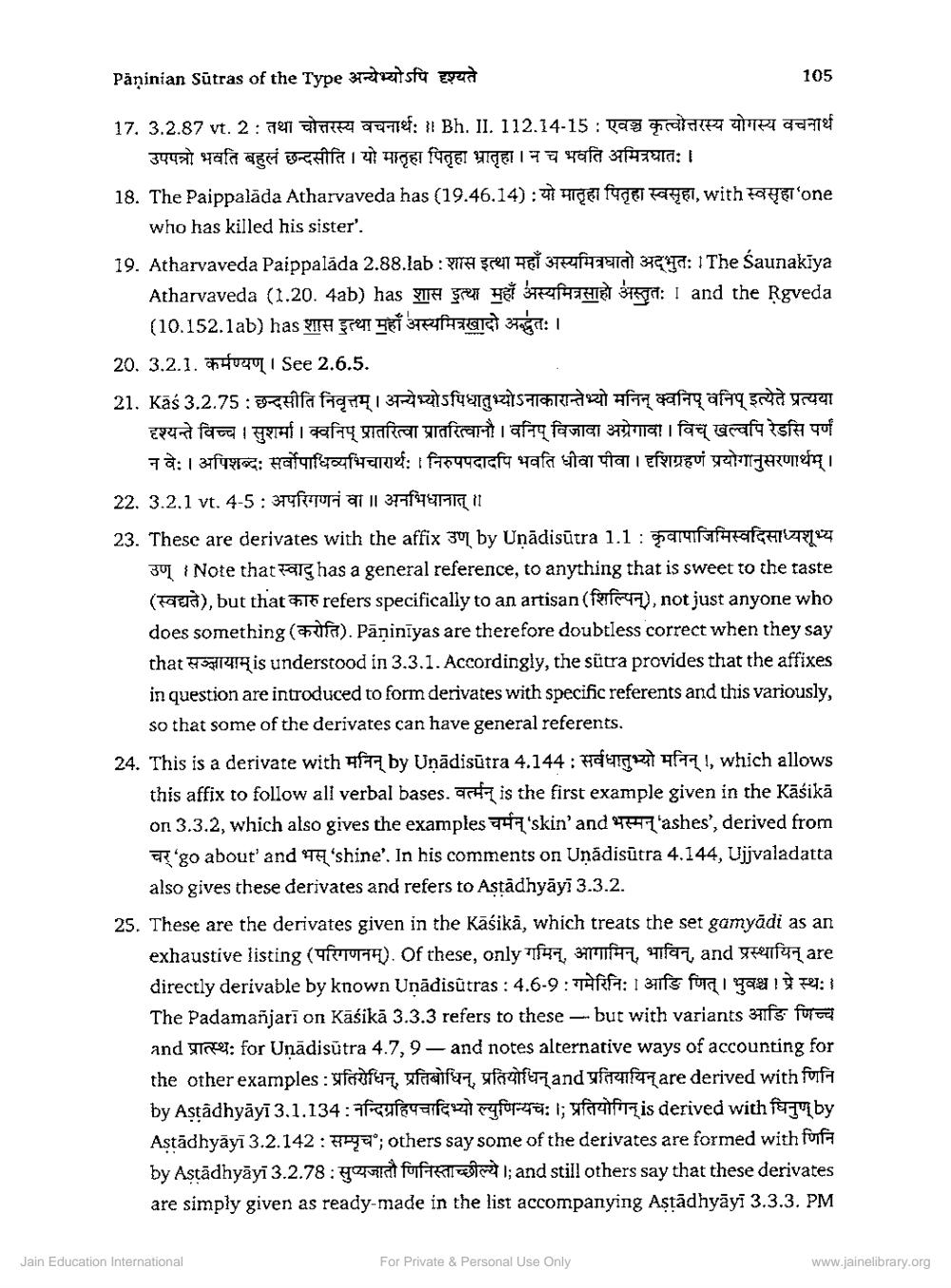________________
Paninian Sutras of the Type अन्येभ्योऽपि दृश्यते
105
17. 3.2.87 vt. 2 : तथा चोत्तरस्य वचनार्थः !! Bh. II. 112.14-15 : एवञ्च कृत्वोत्तरस्य योगस्य वचनार्थ
उपपत्रो भवति बहुलं छन्दसीति । यो मातृहा पितृहा भ्रातृहा । न च भवति अमित्रघातः। 18. The Paippalada Atharvaveda has (19.46.14) : यो मातृहा पितृहा स्वसृहा, with स्वसृहा'one ____who has killed his sister'. 19. Atharvaveda Paippalada 2.88.lab : शास इत्था महाँ अस्यमित्रघातो अद्भुतः | The Saunakiya
Atharvaveda (1.20. 4ab) has शास इत्था महाँ अस्यमित्रसाहो अस्तुत: I and the Rgveda
(10.152.1ab) has शास इत्था महाँ अस्यमित्रखादो अद्भुतः । 20. 3.2.1. कर्मण्यण । See 2.6.5. 21. Kas 3.2.75 : छन्दसीति निवृत्तम् । अन्येभ्योऽपिधातुभ्योऽनाकारान्तेभ्यो मनिन् क्वनिप् वनिप् इत्येते प्रत्यया
दृश्यन्ते विच्च । सुशर्मा । क्वनिए प्रातरित्वा प्रातरित्वानौ । वनिप् विजावा अग्रेगावा । विच् खल्वपि रेडसि पर्ण न वेः । अपिशब्दः सर्वोपाधिव्यभिचारार्थः । निरुपपदादपि भवति धीवा पीवा । दृशिग्रहणं प्रयोगानुसरणार्थम् ।
22. 3.2.1 vt. 4-5 : अपरिगणनं वा ।। अनभिधानात् ।।
23. These are derivates with the affix उण् by Unadisutra 1.1 : कृवापाजिमिस्वदिसाध्यशूभ्य
39Note that has a general reference, to anything that is sweet to the taste (स्वद्यते), but that कारु refers specifically to an artisan (शिल्पिन्), notjustanyone who does something ( fe). Pāņiniyas are therefore doubtless correct when they say that सझायाम्is understood in 3.3.1. Accordingly, the sutra provides that the affixes in question are introduced to form derivates with specific referents and this variously,
so that some of the derivates can have general referents. 24. This is a derivate with मनिन् by Unadishtra 4.144 : सर्वधातुभ्यो मनिन् !, which allows
this affix to follow all verbal bases. Of is the first example given in the Kāśikā on 3.3.2, which also gives the examples चर्मन् 'skin' and भस्मन् 'ashes', derived from चर् 'go about' and भस् 'shine'. In his comments on Unadisutra 4.144, Ujjvaladatta
also gives these derivates and refers to Astādhyāyī 3.3.2. 25. These are the derivates given in the Kāśikā, which treats the set gamyādi as an
exhaustive listing (परिगणनम्). Of these, only गमिन्, आगामिन, भाविन, and प्रस्थायिन् are directly derivable by known Unadisutras:4.6-9: गमेरिनिः 1 आडि णित् । भुवश्च । प्रेस्थः । The Padamanjari on Kasika 3.3.3 refers to these - but with variants आङि णिच्च and प्रात्स्थ: for Unadisutra 4.7,9-and notes alternative ways of accounting for the other examples : प्रतिरोधिन, प्रतिबोधिन्, प्रतियोधिन् and प्रतियायिन् are derived with णिनि by Astadhyayi3.1.134: नन्दिग्रहिपचादिभ्यो ल्युणिन्यचः।। प्रतियोगिन्is derived with घिनुण by Astādhyāyī 3.2.142: APEo; others say some of the derivates are formed with forfa by Astadhyayi 3.2.78 : सुष्यजातौ णिनिस्ताच्छील्ये।; and still others say that these derivates are simply given as ready-made in the list accompanying Astādhyāyī 3.3.3. PM
Jain Education International
For Private & Personal Use Only
www.jainelibrary.org




